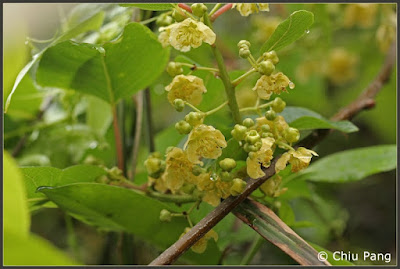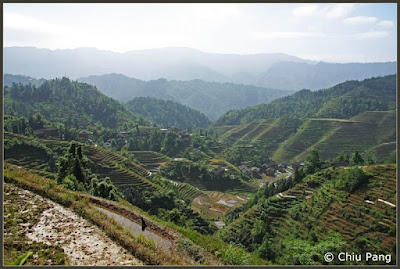

I walked from Yang Ti (楊堤) to Xing Ping (興坪) in order to have a new experience to visit Li River (漓江) apart from joining the boat trip. Not much good view could be seen along the way but you can get closer look on the local villages and farmlands. The walk is not short which spends you about 6 hours to finish.
 Styrax faberi
Styrax faberi (白花龍) was commonly seen in the Longji area.
 Weigela japonica
Weigela japonica var.
sinica (半邊月) was abundant in the Longji area. It's quite unexpected that it is belonging to the family Caprifoliaceae (忍冬科) while I originally thought it is something inside Myrtaceae (桃金娘科).

Several individuals of
Rhododendron stamenium (長蕊杜鵑) was seen in the Longji area. It does look like
Rhododendron moulmainense (
羊角杜鵑) which is native to Hong Kong but the flowers of the former are smaller and the stamens are longer. They belong to the same subgenus.
 Polygonatum cyrtonema
Polygonatum cyrtonema (多花黃精) was also seen in the Longji area.

I enjoyed photographing
Lyonia ovalifolia var.
lanceolata (狹葉南燭) very much as
Lyonia is very rare in Hong Kong and the flowers are so delicate.
 Liquidambar formosana (楓香)
Liquidambar formosana (楓香) could be commonly found in Guilin and Longji.
 Arisaema erubescens
Arisaema erubescens (一把傘天南星) is very common in Longji area while it is so localized in Hong Kong. Montane habitat might be not enough for it to grow in Hong Kong.
 Actinidia chrysantha
Actinidia chrysantha (金花獼猴桃) could be found in both Guangdong and Guangxi provinces.


 Have been to Guilin (桂林) and Longji (龍脊) from late April till early May. A peaceful place to stay and visit while the scenaries are spectacular. It is said that the rice terraces in Longji would be fully flooded at the end of May giving that the most spectacular scene each year. It's really worthy to visit there more than one time to see the different scenes in different times of a year.
Have been to Guilin (桂林) and Longji (龍脊) from late April till early May. A peaceful place to stay and visit while the scenaries are spectacular. It is said that the rice terraces in Longji would be fully flooded at the end of May giving that the most spectacular scene each year. It's really worthy to visit there more than one time to see the different scenes in different times of a year.


 I'd also spent one and a half day to visit Chengyang Wind and Rain Bridge (程陽風雨橋) which is quite far away from Guilin (about 100 km away from Guilin). It is actually part of the buildings by Dong Minority in Guangxi. The buildings in that village all looks traditional as all of them are made by wood. People are nice and the food are great. It's worthy to go if you are interested in these cultural heritage.
I'd also spent one and a half day to visit Chengyang Wind and Rain Bridge (程陽風雨橋) which is quite far away from Guilin (about 100 km away from Guilin). It is actually part of the buildings by Dong Minority in Guangxi. The buildings in that village all looks traditional as all of them are made by wood. People are nice and the food are great. It's worthy to go if you are interested in these cultural heritage.
 I walked from Yang Ti (楊堤) to Xing Ping (興坪) in order to have a new experience to visit Li River (漓江) apart from joining the boat trip. Not much good view could be seen along the way but you can get closer look on the local villages and farmlands. The walk is not short which spends you about 6 hours to finish.
I walked from Yang Ti (楊堤) to Xing Ping (興坪) in order to have a new experience to visit Li River (漓江) apart from joining the boat trip. Not much good view could be seen along the way but you can get closer look on the local villages and farmlands. The walk is not short which spends you about 6 hours to finish. Styrax faberi (白花龍) was commonly seen in the Longji area.
Styrax faberi (白花龍) was commonly seen in the Longji area. Weigela japonica var. sinica (半邊月) was abundant in the Longji area. It's quite unexpected that it is belonging to the family Caprifoliaceae (忍冬科) while I originally thought it is something inside Myrtaceae (桃金娘科).
Weigela japonica var. sinica (半邊月) was abundant in the Longji area. It's quite unexpected that it is belonging to the family Caprifoliaceae (忍冬科) while I originally thought it is something inside Myrtaceae (桃金娘科). Several individuals of Rhododendron stamenium (長蕊杜鵑) was seen in the Longji area. It does look like Rhododendron moulmainense (羊角杜鵑) which is native to Hong Kong but the flowers of the former are smaller and the stamens are longer. They belong to the same subgenus.
Several individuals of Rhododendron stamenium (長蕊杜鵑) was seen in the Longji area. It does look like Rhododendron moulmainense (羊角杜鵑) which is native to Hong Kong but the flowers of the former are smaller and the stamens are longer. They belong to the same subgenus. Polygonatum cyrtonema (多花黃精) was also seen in the Longji area.
Polygonatum cyrtonema (多花黃精) was also seen in the Longji area. I enjoyed photographing Lyonia ovalifolia var. lanceolata (狹葉南燭) very much as Lyonia is very rare in Hong Kong and the flowers are so delicate.
I enjoyed photographing Lyonia ovalifolia var. lanceolata (狹葉南燭) very much as Lyonia is very rare in Hong Kong and the flowers are so delicate. Liquidambar formosana (楓香) could be commonly found in Guilin and Longji.
Liquidambar formosana (楓香) could be commonly found in Guilin and Longji. Arisaema erubescens (一把傘天南星) is very common in Longji area while it is so localized in Hong Kong. Montane habitat might be not enough for it to grow in Hong Kong.
Arisaema erubescens (一把傘天南星) is very common in Longji area while it is so localized in Hong Kong. Montane habitat might be not enough for it to grow in Hong Kong. Actinidia chrysantha (金花獼猴桃) could be found in both Guangdong and Guangxi provinces.
Actinidia chrysantha (金花獼猴桃) could be found in both Guangdong and Guangxi provinces.
No comments:
Post a Comment